Touring Sabah, Borneo
Colorful markets, jungle and tropical islands
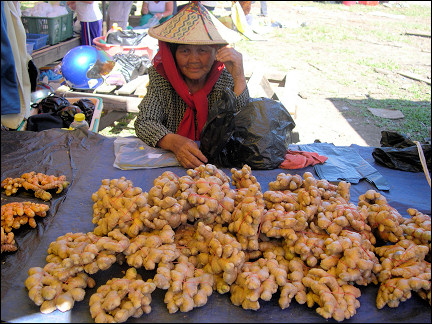
|
The inland of Sabah, a Malaysian province on the island of Borneo, has rainforest in which urang utans and macaques live. Along the coast palm oil plantations catch the eye between ricefields, mangrove forests and sandy beaches. Off the coast are groups of islands like the Turtle Islands and Pulau Tiga. Fishermen go out to sea in little boats or wade in shallow water, fishing with lances. In villages and towns one finds colorful markets and wooden houses on poles.
Travelogue & photos: Jan Noot
Photos: Septima Bramer & Jan Noot
Kota Kinabalu
Lively markets and colorful boats
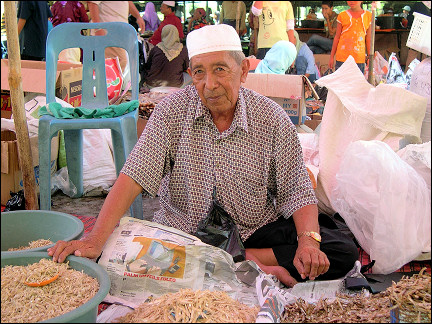
|
We enjoy the lively spectacles in Kota Kinabalu, the capital of the Malaysian province of Sabah on Borneo. There are market stalls with stacks of durians and stalls with only wallets and watches.
Women sit on the ground, their merchandise displayed on pieces of cloth: jewelry, bags of herbs, cinnamon, mangoes, small bananas. Some women are veiled, others wear slacks and shirts.
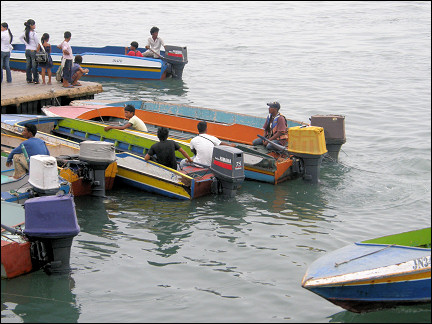
|
Near the harbor is a large indoor market. Inside is a penetrating smell of sewer, rotting fruit and fish. In the harbor, colorful boats are docked.
Wearing life jackets, we sit in a speedboat which takes us to the island of Pulau Manukan. The high speed gives the children a pleasant fairground- attraction sensation. Pulau Manukan is wonderful for sun bathing, swimming and drinking Tiger beer.
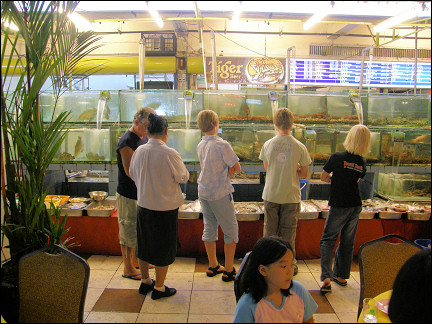
|
The covered place to eat next to our lodge in Kota Kinabalu is surrounded on three sides by crowded fish tanks with lots of fish, huge lobsters, crabs and shrimp. There even is a container filled with big, green frogs, who look at you expectantly with friendly eyes and pulsating throats.
One is supposed to point at an animal, which then is served a little later, wonderfully prepared, on one's plate. Food can't be fresher than this, anyway.
Kota Belud
Women on the market wear headscarves or Chinese hats
A minivan takes us to Kota Belud. Incredible how many people fit in this small vehicle. The English colonial past is still noticeable, traffic keeps to the left.
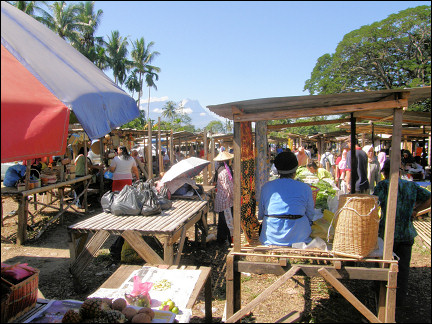
|
We leave the urban area with industrial zones, garages and commercial buildings for densely wooded hills and mountains around Gunung Kinabalu, the second highest mountain in Southeast Asia.
Along the not always well-paved road we see different species of palmtree, bananas and large ferns. There are wooden houses on poles, with roofs of corrugated sheet. In the yards skinny, long-legged chickens and dingo-like dogs roam. The skinny cats often have no tails, they seem to have been chopped off. Here and there old cars sit next to the houses, sometimes mopeds are parked underneath the houses.
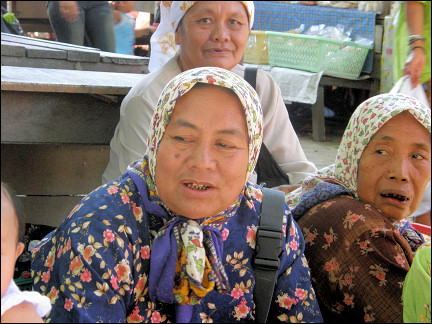
|
Just outside Kota Belud is a large market with simple wooden stalls, covered with corrugated sheet or cloths suspended on ropes. Colorful parasols provide protection from the scorching sun. In the distance we see mountains.
Many vendors sit on the ground, with their merchandise displayed on newspapers. There are many women in colorful clothes, often wearing headscarves, sometimes Chinese hats.
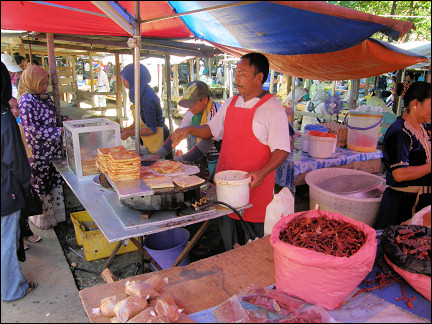
|
There are clothes racks with dresses, shirts and pants. There is jewelry like bracelets, necklaces and rings. Cigarettes can be bought by the pack, but also by the piece. Lot of houseware: plastic cups, buckets, wicker baskets and lampshades.
There is also a lot of food: prawn crackers in cellophane, an endless variety of fruit, vegetables in neat stacks, pyramids of dried fish (just the smell!), peppers and ginger root.
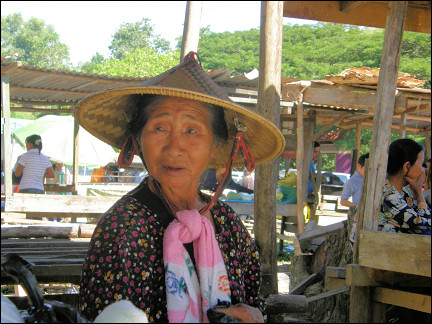
|
One can eat and drink here as well. There are containers filled with colorful fruitjuices. With a large wooden spoon cups of transparent plastic are filled. There are stalls where cookies are baked or slices of meat fried.
Poring
In Kinabalu NP the largest flower in the world is blossoming
In a tight minivan we drive to Ranau. The landscape gets rougher and the road climbs steeply. Gunung Kinabalu is obscured by clouds and the rain gets worse. Still we drive with the windows open; it smells nice and fresh.
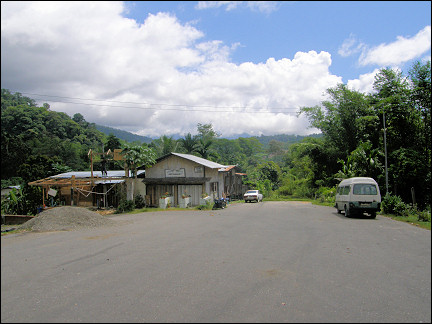
|
Here and there skinny, brown cows lie on the roadside. There is beautiful giant bamboo. We see the first ricefields. In many places the rice shoots are no more than a green haze over the shallow water.
We find a simple hotel in Poring, near the entrance of the Kinabalu nature park, with a view of the foggy, green hills: orang utans in the mist! The back borders on the jungle. At night there is a concert of squeaking, chirping and buzzing insects, every now and then interrupted by the loud call of a nightbird.
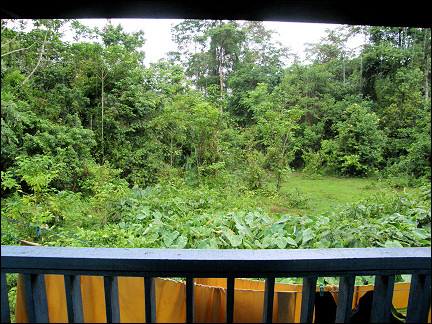
|
Poring is one long street, with on one side stores in wooden barracks. On the other side is the office of Kinabalu nature park.
With a couple of young guides we search for the rafflesia, a plant which has the largest flowers in the world, and only grows on Sumatra and Borneo. The flowers, which have diameters up to a meter, only last a few days.
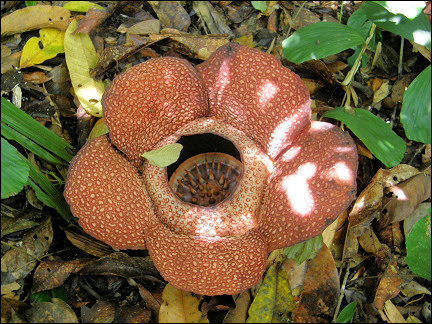
|
It's boiling hot and almost cloudless during the short hike through the jungle, which is still steaming from the rain. The ground is muddy and slippery, the vegetation overwhelming: thick trees with strong aerial roots, decimeters thick bamboo and dense shrubs.
We find an exquisite, if not very large, specimen of rafflesia, with a 50 centimeters diameter.
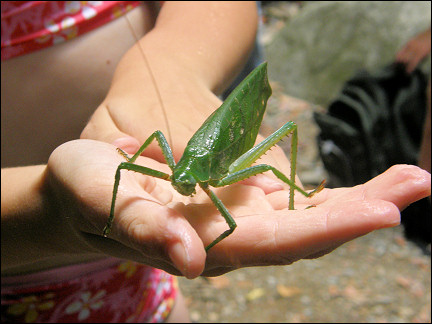
|
Later we enter Kinabalu nature park along (too) neatly constructed paths with handrails and signposts. It gets better: slippery paths, trees that seem to touch the clouds, lianes, supersized houseplants and swirling rivers.
We hear lots of pretty bird sounds, but the birds themselves stay hidden. We see black squirrels chasing each other on branches and treetrunks. Near a beautiful waterfall we refresh ourselves in a pool. We see a large walking leaf.
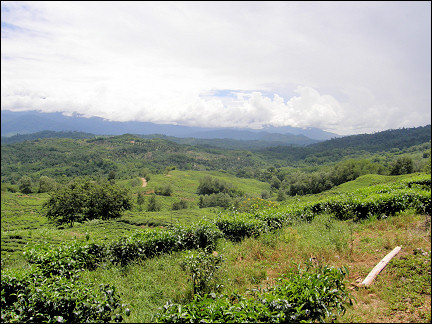
|
On the nearby tea plantation Sabah Tea Garden we get a tour of the tea factory, after watching a commercial video. The whole process is explained, from picking tea leaves to packing the dried tea. We are not allowed to take pictures of the drying process: company secret.
As far as the eye can see there are tea shrubs on the hillsides. The surroundings are gorgeous: hills in the distance, steaming in the bright sunlight, a blue sky with white cumulus clouds.
Sepilok
Markets with vegetables and bananas, lots of bananas
It's 200 km to Sepilok, which will take us 4 hours. In Poring we rent a cab and a kind of Landrover, because there's eight of us and as many backpacks.
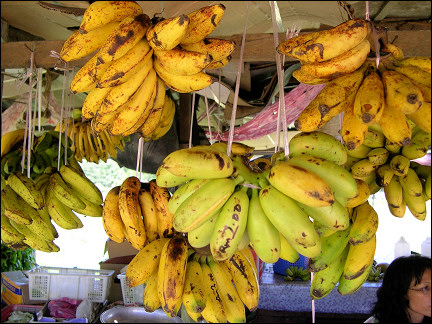
|
The jungle gives way to palm-oil plantations. Malaysia is one of the biggest palm oil producers in the world. The oil palms are pretty with their thick, bizarrely shaped trunks and their branches and leaves like dark-green feathers of giant birds. It's less than pretty how much jungle has been destroyed for these plantations.
On the way we pass markets with vegetables, tomatoes, fried chickenwings, bottles of water, fruit juices, prawn cakes, herbs and bananas, many, many bananas.
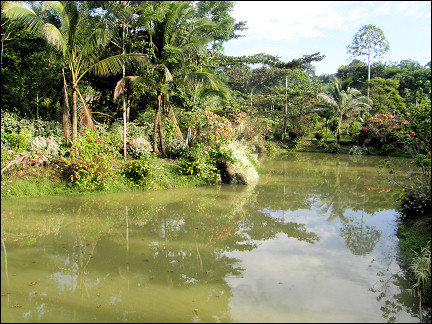
|
Sepilok is a 'must' for this trip, because of the orang utans and also because all kinds of tours leave there: to the Turtle Islands and a jungle tour on the largest river of Sabah, the Sungai Kinabatangan.
Unfortunately we can't do everything by ourselves, so this time we take a few organised trips. We stay in a jungle resort with a spacious, park- like garden.
Turtle Islands
All of a sudden, the nest spits out tens of little turtles
On the tourbus, the guide talks incessantly. Why again didn't we like these tours? Near a landing, a few boats float on the brown water. It's muggy.
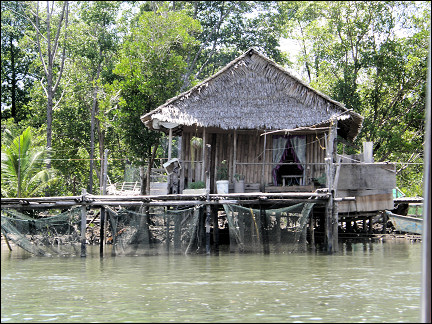
|
The boat navigates the river, which meanders like a ribbon through the mangrove woods, at an enormous speed. We pass small settlements with high, rickety houses with landings with fishnets. Some houses have collapsed into the water.
All of a sudden, we're on the open sea. On the horizon are islands like yellow ribbons with a dark-green lining. On an island we have lunch and look around in the idyllic fishers village.
The view of the next island is overwhelming: a bright yellow beach and thin, high palmtrees. Near the beach the sea is bright and light-blue and where it gets deeper, it's green-blue. The sun shines in a bright-blue sky.
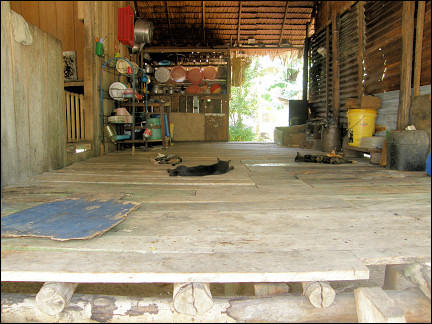
|
It is one of the Turtle Islands, where turtles lay their eggs on the beach. The eggs are hatched in a controlled way to save the decreasing turtle population. The money to do that is earned by allowing small groups of tourists to visit the island.
After a few hours of lazying on the beach with a view of the Philippines in the distance, in the bush next to us a nest of turtles hatches out: from a hole in the ground the little turtles appear one by one.
All of a sudden the nest hole bursts open en spits out tens of turtles at a time. They run in all directions, swarming over each other and over our feet. They feel nicely soft and warm. The rangers put some turtles in our hands, so we can place them carefully on the beach, so they can find the way to the sea quickly. It's an unforgettable sight.
In the restaurant we wait after dinner. By 10 PM we are told that a turtle has arrived on the beach. Quietly and without light, we leave with the rangers to look for it. The huge turtle has already layed many eggs, which look like slithery lychees. The eggs are carefully gathered, and then the turtle covers the nest.
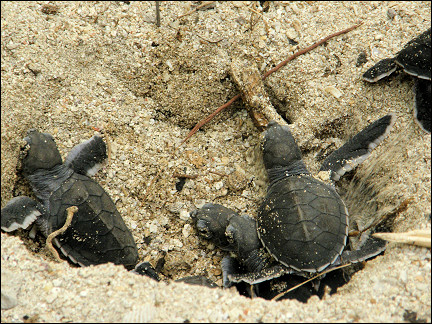
|
The famous crying of the turtle is beautiful: she says goodbye, as it were with tears in her eyes, to her offspring which she'll never know. Only after 2-3 years the turtle will return for another nest.
We go to the breeding place where the eggs are buried. It looks like a military cemetary with green cylinders in straight rows in the sand, bearing signs with date, code number and amount.
It takes 50-60 days for the eggs to hatch. Temperature is related to the sex of the turtles: higher temperatures yield females, lower temperatures males. The difference is only a few degrees.
Sepilok Orang Utan Rehabilitation Centre
The apes appear out of nowhere between the foliage
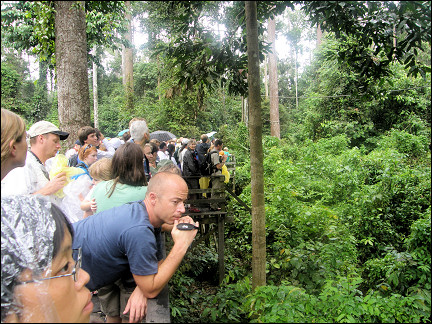
|
We leave the turtle island early and take the bus to Sepilok Orang Utan Rehabilitation Center, where orang utans that lived in captivity or which lost their parents are taught to live in the jungle by themselves. Some of the animals still need to be fed, a spectacle we love to show our kids.
We walk a few hundred meters on wooden walkways into the jungle, which is dominated by straight giant trees. On a big wooden platform a crowd has gathered, armed with cameras. It starts to rain a little.
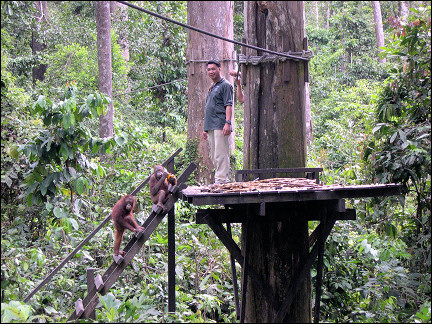
|
The feeding site is a round wooden plateau around a big tree, which can be reach by stairs and ropes which are suspended between trees. When the guards arrive with long stem of sugarcane and bunches of bananas, the orang utans show themselves almost immediately.
A few orang utans walk calmly over the wooden handrails of the audience platforms. Others appear out of nowhere between the foliage and swing from rope to rope to the feeding plateau. We see approximately 15 orang utans: young and old, mothers with young, sturdy males.
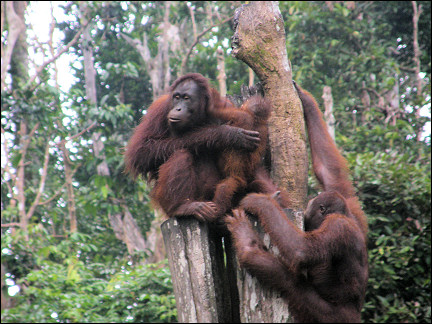
|
Some eat a few bananas and then disappear. There are apes who fold the sugercane stalks on a rope and drink the sweet liquid that is released.
A young male, who apparently studied the Kama Sutra, enthousiastically practises what he read with an unwilling-looking female, watched by the audience, of whom especially the young kids watch the unexpected spectacle with red cheeks.
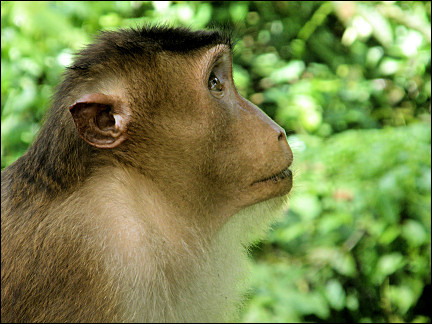
|
After an hour most orang utans leave, making place for a large group of noisy macaques. They eat the leftovers, at a respectful distance from the remaining orang utans.
Sungai Kinabatangan
On the banks sit some wooden houses and tall palmtrees
The route to Sungai Kinabatangan is dominated by palm oil plantations. The scaly trunks of the oil palms are overgrown with fresh-green ferns and creepers. The kampongs again have wooden houses on poles.
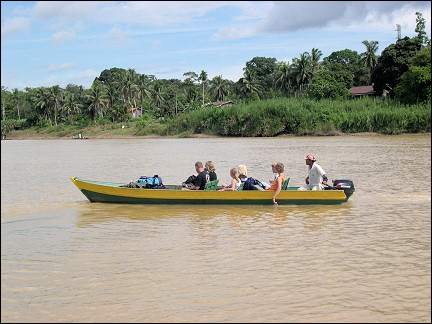
|
The bus stops at a large wooden landing on the river. We see a yellow-black mangrove snake curled around a tree branch. A small boat takes us to our lodgings at the other side of the river.
The Sungai Kinabatangan is wider than we thought. On its banks sit a few wooden houses and tall palmtrees. The lodge has simple rooms, with small, cheerfully tiled showers that don't work (but the bucket works fine) and a washstand with two faucets, one of which is dry.
Soon we embark for our first river tour; we have to wear life jackets. There are several boats with each 6-12 tourists. If there is anything interesting to see, all boats converge there.
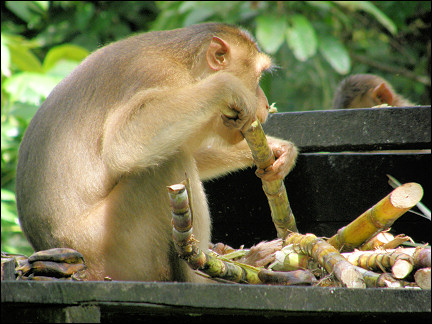
|
We see mainly large groups of proboscis monkeys, which stare at us curiously from the tall trees. The dominant male, with its pronounced nose, always takes a central position in the tree. With lots of noise and rustling the monkeys jump from branch to branch.
We also see different kinds of macaques; some have long tails which hang motionless when they sit in a tree eating. Black hornbills fly from tree to tree, alone or in couples. Every now and then they cross the river. White herons sit motionless on branches and fly off, screeching protests, when the boats get too close.
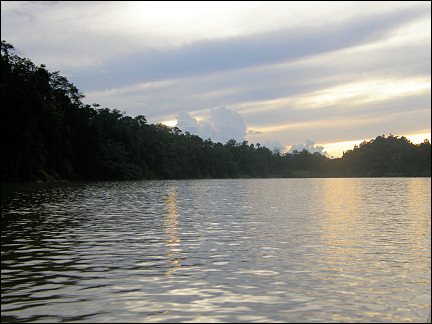
|
The rain increases, making it hard to discern the animals. After a tour of almost three hours we return to the lodge at high speed.
In the evening we take a walk in the jungle in the dark. The felines, Borneo pygmy elephants and rhinoes we hoped to see don't show themselves. But we see treefrogs, a scorpion and large centipedes.
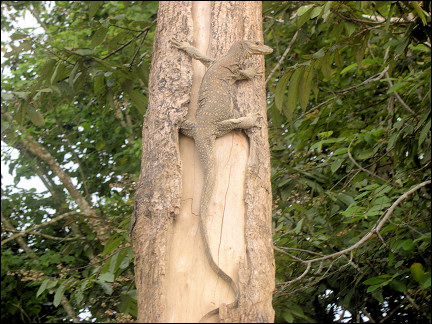
|
Our second boat tour is at first spoiled by fog. We can't even see the other side of the river. Slowly trees appear from the low clouds. The water of the Sungai Kinabatangan feels like warm bathwater.
We see some small crocodiles and an adult one which is a couple of meters long. The macaques are hiding this morning, but we see some proboscis monkeys. A huge lizard holds on to a tree, keeping so still that one wonders if it is stuffed. We see two different kinds of eagle, which sit high in tree tops, on top of the world like kings.
Sandakan
The fish at the market are fresh: some are still gasping for air
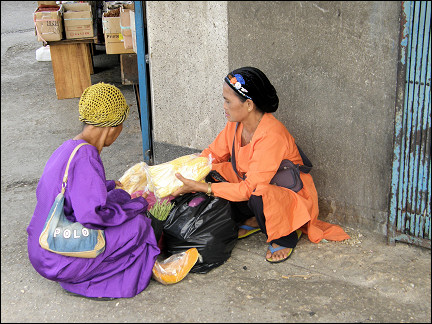
|
By tourist coach and then by local bus, filled with children in school uniforms and young mothers with small children on their laps, we travel to Sandakan. There is loud, very loud, Malaysian music, the young ticket vendor sings along at the top of his voice.
The center of Sandakan is between the sea and a chain of hills. The sea at the harbor smells unpleasant. We walk for hours through crowded streets with countless restaurants, jewellers, open sewers covered with large stones and hundreds of billboards with Chinese characters.
The mosque of Sandakan can be reached by a long, steep, covered stone stairway. We are treated kindly everywhere. Some men shake our hands and seem overjoyed by our visit.
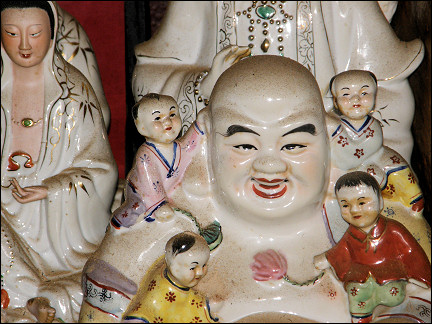
|
The atmosphere in the Taoist temple is serene. Much incense, pretty sculptures and paintings of gods, red-lackered cabinets and tables. We are allowed to take pictures and can keep our shoes on.
Between lush vegetation we climb the hill via the "Hundred steps stairway" and have tea in an English-looking tea house with a fantastic view of the city beneath us, the blue sea and an island in the distance. Next to the English Tea House is the restored colonial mansion of author Agnes Keith. A beautiful house with elegant columns and windows.
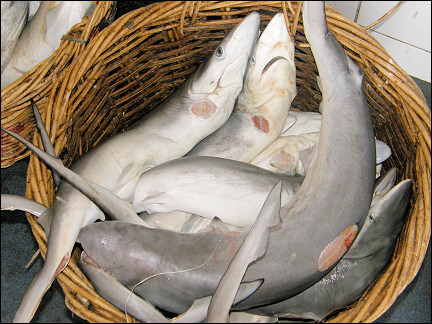
|
For the first time during this vacation I wake up early because of the call to prayer by the muezzin from the minaret of a nearby mosque. In our hotelroom an arrow points toward Mecca.
At the indoor market near the harbor are endless rows of tables, laden with vegetables, fruit, herbs, shrimp cakes and high stacks of dried fish. Outside the fishmarket, the fishermen are negotiating with the buyers, gesticulating frantically. Inside one finds an incredible variety of fish and crustaceans. We see stingrays, sharks, barracudas, tunas, catfish, flatfish, red searobins and many fish unknown to us. At lot of fish are overly fresh and are still gasping for air.
Mesilau
Fog floats between the trees of the rainforest
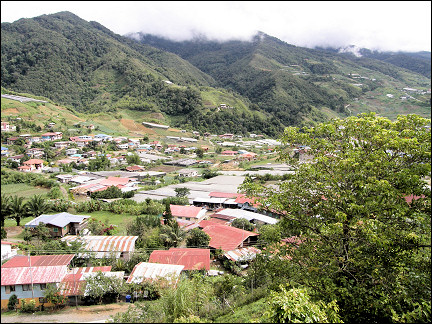
|
The road to Mesilau, in the nature park near Gunung Kinabalu, is steep and in a bad condition: the driver often has to swerve around deep potholes. On the hillsides and in the valleys sit many houses with corrugated sheet roofs. It's remarkable how busy it is here.
Large surfaces of soil are covered with long clothes that function as greenhouses. The high mountain is completely obscured by clouds, which come rolling in over the mountain tops. It gets noticeably cooler.
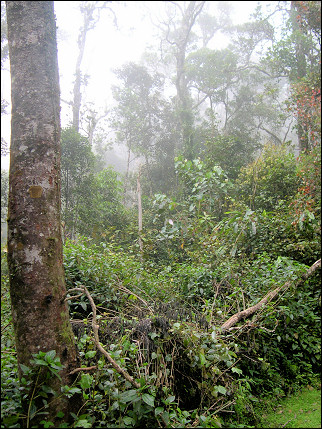
|
The surroundings of Mesilau Nature Resort (in the middle of the rainforest) are wonderful, especially now, when fog floats calmly between the trees. The chalets on wooden poles are amazing, with wooden stairs, porches, shiny painted panelling, corner seats, television, three bedrooms with each its own bathroom, a living room with mineral water and watercooker, tea and coffee.
We take a walking tour with a group of Japanese and South-Koreans. The guide's enthousiasm is contagious. It's more like a botanic adventure than an exhausting hike. We see gorgeous orchids (sometimes growing on moss-covered tree trunks, sometimes growing independently), rattan cane with thorny stems, bright-red flowers of the lipstick plant and different kinds of giant moss.
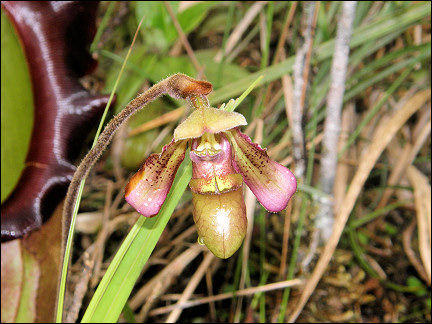
|
We climb over flat stones, wooden stairs, slippery tree roots and a suspension bridge, which spans a swirling brook. Because of the noise of the water it's never really quiet here. And it's markedly cool at 1800 meters. The guide tells us that the Gunung Kinabalu is the youngest mountain in the world and still grows 5 millimeters every year. Now, that is a fun fact.
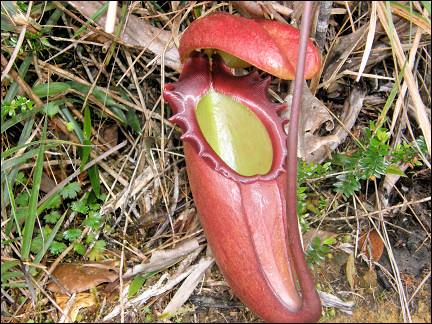
|
A large carnivore plant, the pitcherplant, grows in this region. The flowers are red and green pitchers filled with a liquid; they have lids that never close. The flowers blossom for over a year, growing from the size of a fingernail to over 25 centimeters.
Tenom
Vast ricefields, lined with palmtrees
We return from the cold weather in Mesilau via Ranau to the heat and make a short stop at a war memorial, which commemorates hundreds of English and Australian soldiers who died here between 1944 and 1945 in horrible circumstances.
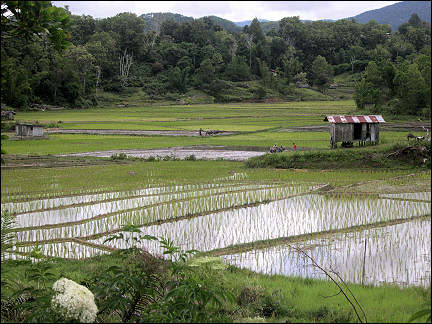
|
The first part of the road to Keningau has brand new asphalt, but only for a short stretch. After that, there sometimes is hardly any paving at all, only pebbles, rocks and deep potholes.
The hills and mountain tops on our right are shrouded in low clouds. We see vast ricefields, lined with palmtrees. Here and there are shiny water buffalo and people working in the fields.
On the roadside stand and lie brown cows with long horns. We also see horses, goats and sheep along the road. Everywhere listless dogs loaf about the streets, sometimes lying in the middle of the road. Big stacks of red-brown palmoil nut bunches sit on the roadsides and will be collected by men with trucks.
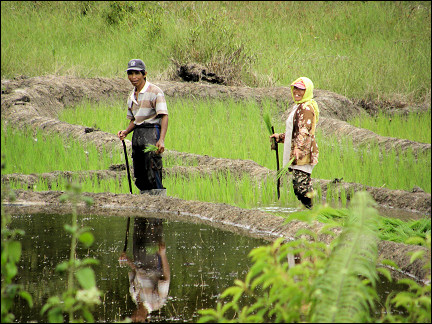
|
It starts to rain again, even though it's the end of July and the rainy season only begins in October. After lunch in Keningau we are crammed into a minivan, which we didn't expect to be able to hold the eight of us.
Tenom is a pleasant town with many stores, mostly islamic restaurants, some soccerfields with stands and a train station.
We visit a Murut village, or rather: a kind of open-air museum with Murut longhouses. The Murut are one of 32 ethnic groups in Sabah. In the large main building pottery is made and hats are twined; children can shoot arrows with blowpipes.
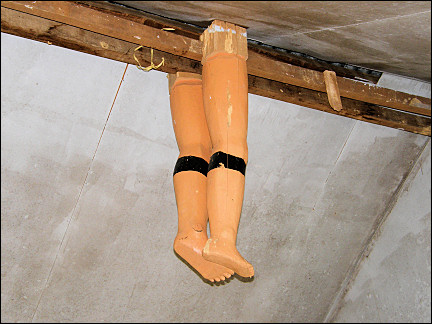
|
In a separate wooden building ceremonies are held and games are played. There is a bamboo cushion on which you can jump to grab a pair of wooden legs that are suspended from the ceiling. It requires a lot of strength.
On our way to the Agricultural Center, a little outside Tenom, we see a small rubber plantation. The tree trunks have been stripped of their barks in several places. Black containers which are attached to the trees hold the white, sticky substance.
The Agricultural Center is a huge complex with a surface of over 600 hectares and it is clearly prepared to receive large groups, even though for the largest part of the day we're the only visitors. The center is located in park-like surroundings, with a botanical garden and a large garden with all kinds of edibles.
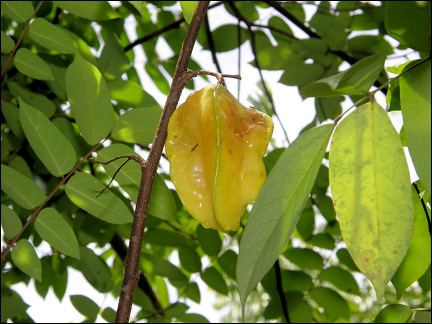
|
The guide involves the children in the tour in a nice way; he lets them taste all kinds of things, smell and feel them: cinnamon, nutmeg, pineapple, cocoa, coffee, tea, papaya, lime, canon-ball tree, starfruit (carambola) and bananas.
With the train to Beaufort
Along a foaming brown river and green hills
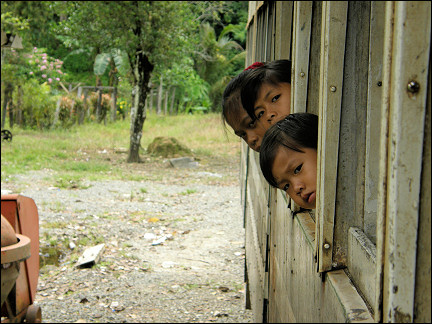
|
The only working train connection on Borneo is the one between Tenom and Beaufort. We are the only tourists on the train. The windows don't have glass, but there are shades which have been pulled down. The train wagon swings from one side to the other.
Most of the journey the speed is nerve-wreckingly slow. It's possible to stand on the footboard in the open door and enjoy the trip with the wind in your hair. The railroad tracks follow the Sungai Padas, the second river of Sabah after Sungai Kinabatangan.
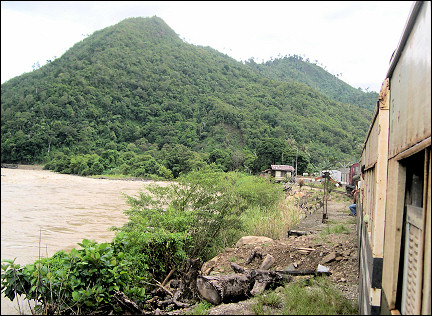
|
The landscape is gorgeous with this foaming brown river, the green hills, the wooden houses with porches, the palmtrees and the bananas. On the way we now and then stop at a small train station, but sometimes also in the middle of nowhere, to let off a few road-construction workers.
Pulau Tiga
Staying in a longhouse between the jungle and a white beach
Beaufort has a pretty old train station with stone stairs, where elderly women sell all kinds of fruit. In a minivan we are driven to the port town Kuala Penyu. The terrain here is level and very green.
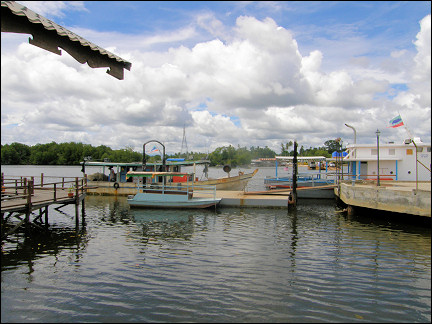
|
We get out at the pier in Kuala Penyu, where a boat leaves for Pulau Tiga, a group of three islands ("tiga" means three) not far off the coast. In a wooden building by the pier we book accomodation on Pulau Tiga.
Empty jerrycans are stacked on the pier. In the water enormous shoals of minuscule silvery fish and larger needlefish swim around. During the outgoing tide we see mudskippers jump in the mud, king crabs shuffle like walking scissors and regular crabs run sideways at incredible speed on the damp sand. A sniffing stray dog makes all these animals dive for cover in the sand in a second.
When the boat from Pulau Tiga arrives, it first loads boxes of oil, mayonaise, eggs and a big bag of onions from New Zealand. Then it refuels: the jerrycans are filled with diesel oil at a gas station.
The boat has two 100 pk outboard motors. Within a few seconds we race over the water with a deafening noise. The boat rises from the water every now and then, only to come down again with a loud bang. Luckily, the trip takes only half an hour.
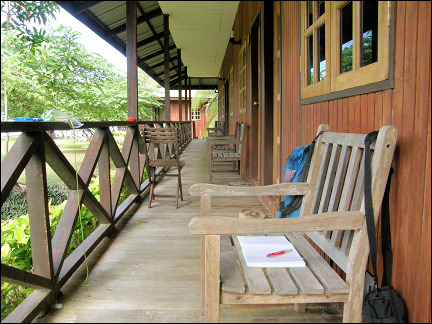
|
On Pulau Tiga we stay in a longhouse, an elongated wooden construction on short poles, with wooden stairs, a porch and five rooms. At the back, it borders on the jungle and it's only 50 meters from the white sandy beach and the light-blue water of the South-Chinese Sea.
Black and white butterflies flutter around, they're as big as saucers. In the distance we see macaques walk on the beach. There is a large restaurant where we have to take off our shoes. On the beach are wooden benches, where we drink ice-cold Tiger beers.
In the evening we again hear the exciting sounds of the jungle. It rains for a long, long time. In our room all of a sudden a gecko jumps on my arm. An interesting sensation, as if four small sucking cubs attach themselves to you simultaneously.
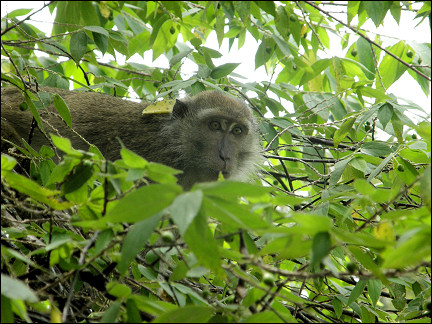
|
Next days it's sunny and hot, the ground is still pleasantly damp. Around noon we see macaques, walking leasurely between the houses or sitting on porches and roofs.
At first we think it really special, but soon it becomes a normal sight. Sometimes they aggressively show their teeth when one gets too near. I even see some macaques run after screaming girls!
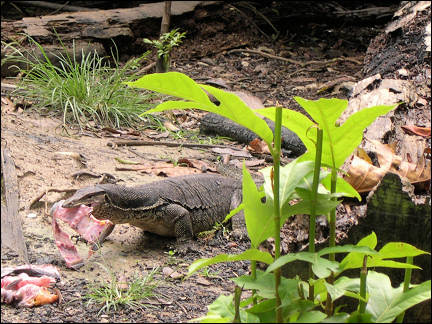
|
Behind the restaurant are a couple of enormous lizards (a kind of Komodo dragons), each measuring a few meters. They are fed with large lumps of raw meat, which they wolf down savagely.
Looking for a mud pool we take a slippery tour of the jungle, over damp tree roots and muddy stones. In the forest are meters-high termite mounds. We hear exquisite bird sounds from the trees, but the birds themselves we don't get to see.
It takes a lot to get yourself to glide into the mud, it feels very gross at first. But once you're in, it is a special experience. Like grey forest spirits we walk to the beach afterwards, to rinse the mud from our bodies in the seawater.
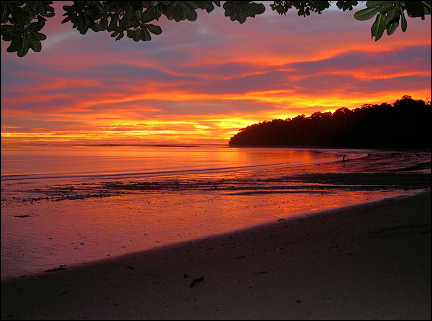
|
The evening ends with an incredibly beautiful sunset, with a rainbow in the distance as a bonus. It's been dry all day, one of the few times until now.
Pulau Kalampunian Damit is also called Pulau Ular, or: snake island. On this second of the three Pulau Tiga islands extremely poisonous sea snakes come out of the sea to mate. A small boat takes us there over the turquoise water. Pulau Ular is rocky, with tall trees which have beautiful, bizarrely shaped roots.
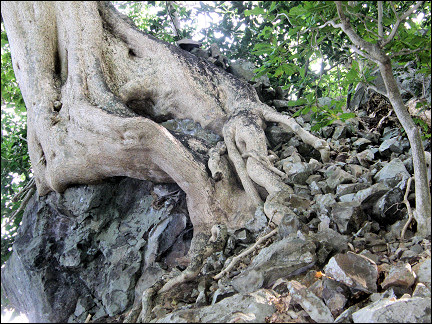
|
There is no landing, we climb out of the boat and jump over rocks to the beach. After a few minutes we already see a thick grey snake with black stripes, hidden between rocks. All in all we see three sleepy snakes, a less exciting spectacle than what we'd hoped for.
After 15 minutes we are picked up and taken to the third island. Pulau Kalampunian Besar is an elongated sandbank, a small part of which is overgrown by strong ground cover plants with light-green leaves and tough stalks.
It's scorching hot today, there is no cloud in the sky. In the distance we see Pulau Ular like a green wig on the horizon. On the white sand lie pieces of coral, driftwood and a few shells. After an hour we are picked up and brought back to Pulau Tiga.
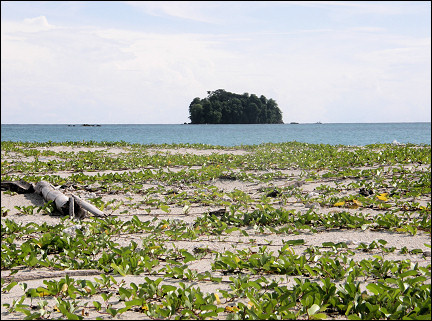
|
We sail out to snorkel. There is a strong wind and the sea is swelling. We see gorgeous fish, among others: clownfish and a small octopus. Initially the weather is good, but that changes later. At night the heavy rain wakes me up, it drums on the corrugated sheet roof with loud bangs.
We take a last jungle tour, with at first the literally deafening, monotonous noise of insects. Deeper into the jungle the noise stops. We have to force our way through the jungle along mud pools, fast-flowing brooks, huge tree roots and giant umbrella papyruses. There are plants with thorns as big as knitting needles.
We see hundreds of thousands of ants march in columns on the swampy ground, dragging eggs and captured insects, continuing their way over trunks of giant trees and trees that seem to stand on stilts because of the height of their roots. We see lignified lianas shaped like corkscrews and lassos. Here and there macaques sit high up in the trees. On the ground a large, dark-colored bird runs around, a kind of forest chicken. One tree has a perimeter of tens of meters, a sequoia is nothing in comparison to this.
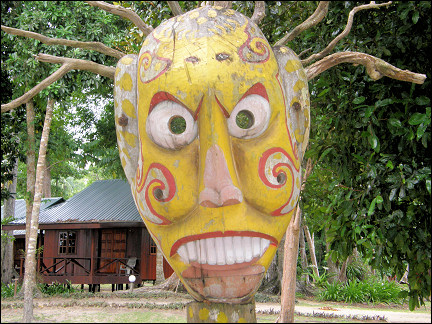
|
Our last day on Pulau Tiga, again lots of rain and wind. The waves batter the coast. The boat ride to Kuala Penyu is not pleasant at all. The boat jumps and bangs on the water, we rock back and forth and the boat almost capsizes. Most of us are soaking wet.
When we approach the mainland of Sabah, the wind dies down, the dark sky breaks open and the sun appears.
Kinarut
Fishermen wade through the water with long lances
We spend our last day in Kinarut, a village on the coast near Kota Kinabalu. The beach is littered with washed ashore junk, driftwood, coconuts and plastic bottles. Some stray dogs roam the beach, playing with the coconuts. In the distance lie a few green islands.
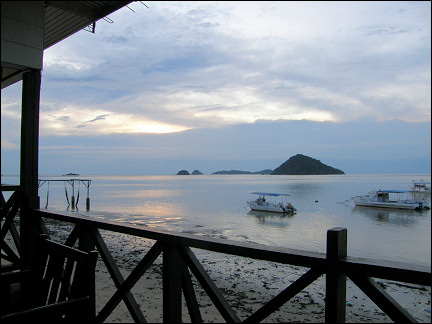
|
After dark we see a couple of white herons on the beach and the lights of the lamps the fishermen take with them; they wade waistdeep through the water with long lances in their hands. A large bat flutters between the palmtrees to catch insects.
In the light from the restaurant moths swarm. Geckos catch the moths in the air superfast and eat them with a cracking sound.
The evening ends in style with a tropical rainshower after a few wind gusts. The rain stops as fast as it started. The day of our return trip starts rainy and overcast, but it gets better soon. By the end of the afternoon we take two cabs to the airport.